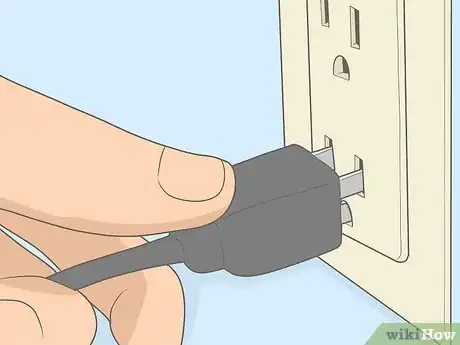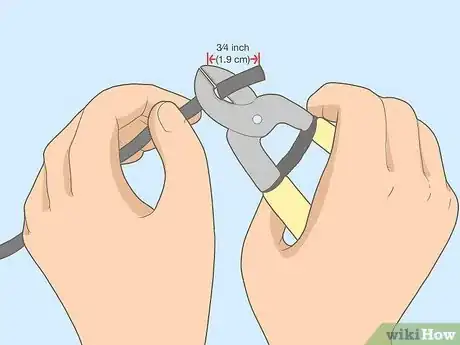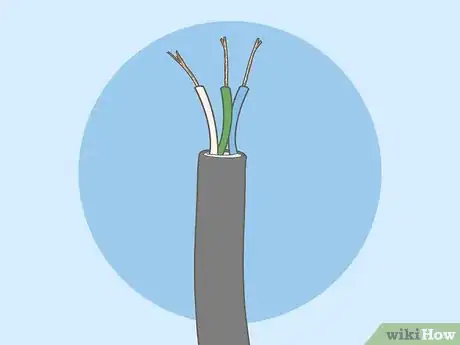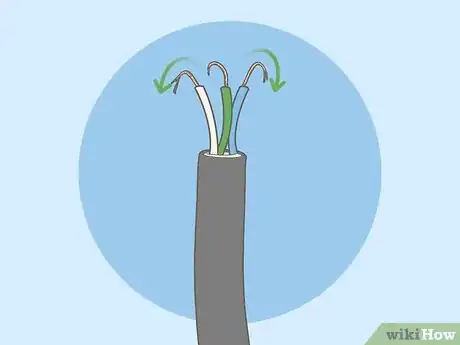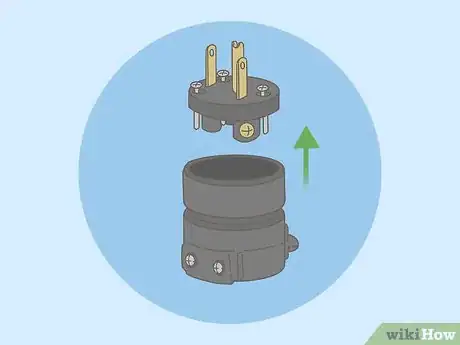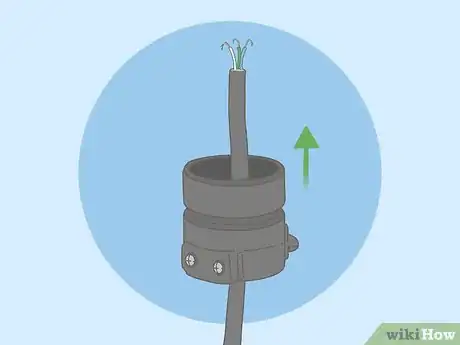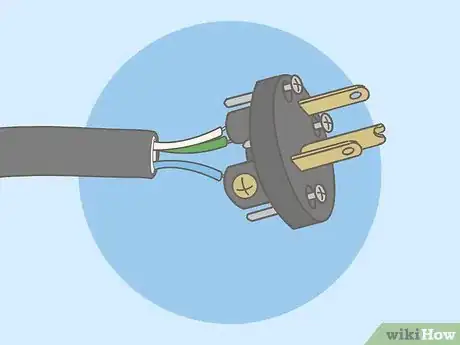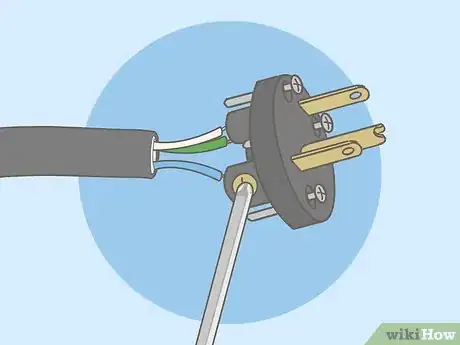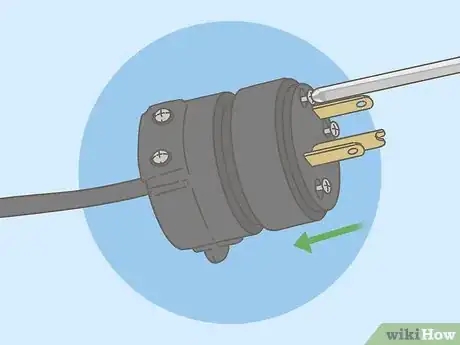This article was co-authored by Marvin Woo. Marvin Woo is a licensed electrician and the Owner of Woo's Electrical & Appliance based in East O’ahu. With over two decades of experience, he specializes in troubleshooting issues and maintaining residential electrical systems. Marvin is both licensed and insured to complete electrical work in the state of Hawaii.
There are 9 references cited in this article, which can be found at the bottom of the page.
This article has been viewed 40,029 times.
The plugs on appliances or extensions cords can wear out or get damaged over time. However, you don’t have to spend money to get an entirely new cord. For just a few dollars, you can get a replacement plug and attach it yourself. This only takes a few tools and minimal knowledge, and your cord will be good as new when you're done.
Steps
Removing the Old Plug
-
1Get a replacement plug end from a hardware store. Most hardware stores will have replacement plugs in their electronics sections or near the extension cords. Make sure you match the new plug with the type of cord you have. Get a 3-pronged plug for a 3-pronged cord, and a 2-pronged plug for a 2-pronged cord.[1]
- Check the instructions on any new plug you get. The installation instructions might be slightly different between different products.
- You can also buy replacement plugs online.
-
2Unplug the cord before you start working on it. Never work on an electric appliance without unplugging it first. Make sure the cord is unplugged on both sides before you start.[2] [3]
- If the cord attaches to an appliance on the other end, you can leave that attached as long as the appliance is unplugged from an electrical socket.
Advertisement -
3Cut the wire just below the base of the plug. Take a wire cutter and align it about 1⁄4 in (0.64 cm) below the end of the plug. Cut straight through the wire to detach the old plug.[4] [5]
- Don’t use scissors or anything else that isn’t designed for cutting wires. You need to get a clean cut to avoid damaging the cord.
- Some appliances have removable plugs. In this case, remove the old plug by removing the screws holding the body together and open it up. If the cord is connected to screws inside the body, unscrew these as well to remove the cord. Then cut the wire below where the plug ended to use the fresh parts of the wire.
-
4Strip off 3⁄4 in (1.9 cm) of the cord jacket to expose the wires underneath. Use a wire stripper and wrap it around the cord 3⁄4 in (1.9 cm) from the end. Squeeze it and rotate it around the cord to cut through its outer housing. Then slide the jacket off. This exposes the 2 or 3 wires underneath, depending on the type of cord.[6] [7]
- Don’t cut back further than this because the wires underneath shouldn’t show when you install the new plug. If you cut too far back and can still see the inner wires when you put the new plug on, cut the ends off the wires so they aren’t too long.
- If you don’t have a wire stripper, you could also use a utility knife or razor blade. Cut around the wire jacket with the edge of the blade. Be very careful with these tools. Wear thick gloves and place the cord down on a flat surface so you don’t slip.
-
5Shave off 1⁄2 in (1.3 cm) of insulation on each wire. When your remove the outer jacket, you’ll expose 2 or 3 wires inside the cord. Separate the wires so they aren’t touching. Then, use the wire stripper and strip 1⁄2 in (1.3 cm) off the end of each wire to expose the copper underneath.[8] [9]
- These wires have different color jackets, which tell you what their role is. The ground wire is green, the neutral wire is white, and the hot wire is black. A 3-pronged cord has all 3, and a 2-pronged cord only has a hot and neutral.
- Make sure you leave enough housing on the wires that you can still see the jacket color. This is important for putting the wires in the correct place.
- You can also use a knife or razor to do this job. Remember to wear gloves and work on a flat surface.
-
6Bend the copper portion of each wire into a U-shape. Grab the end of each wire and bend it backward to make a hook. This makes attaching them to the new plug much easier and more secure.[10]
Installing a New Plug
-
1Unscrew the housing of the replacement plug. The new plug is held together by a few screws. Turn each one counterclockwise to loosen and remove them. Then open up the plug housing.[11]
- The plug housing looks different depending on the type of cord it connects to. Extension cords usually have a rounded plug, and you'd remove screw around the tip of plugs to pull off the front part. 2-pronged plugs usually come apart lengthwise when you remove the screws along the side of the housing.
- Keep track of all the screws you remove so you can put the housing back together when you’re done.
-
2Slide the plug base onto the cord if it has a detachable base. Some plug types, particularly extension cord plugs, have a removable base. In this case, slide the base onto the cord right-side-up first. Otherwise, you won't be able to fit the base over the plug after you've installed the wires.[12]
- If you forget to do this, you can still attach the base when you've already installed the plug. Slide the base over the other side of the cord.
-
3Loosen the terminal screws inside the plug. Depending on the cord type, the plug will have 2 or 3 terminals, each with a screw and a small metal covering. These are on different sides of the plug so the wires don't touch each other. Locate all the terminals by looking all around the plug housing. Loosen each screw to open up enough room for a wire in each terminal.[13]
- On some models, it’s easier to remove the screws completely instead of just loosening them. If you do remove the screws, don’t lose them.
-
4Tuck each wire into the corresponding terminal. The screws have colors that correspond to the wires.[14] The green screw is for the green ground wire, the silver screw is for the white neutral, and the brass screw is for the black hot wire. Take the correct wire and tuck it into its corresponding terminal. Try to loop it around the screw so it stays in place.[15]
- Remember that a 2-pronged plug only has 2 terminals, a hot and neutral. The screws should also be brass and silver.
-
5Tighten the screws to lock the wires in place. With the wires in place, take your screwdriver and tighten up all the terminal screws. Make each one snug so it holds the wires in place, but don’t force the screws to go tighter than this. A snug fit is enough to keep the wires in place.[16]
- Pull on each wire slightly to make sure it’s secure. Then shake the cord and housing to test the connection. The wires should stay in place.
-
6Reassemble the plug housing. Close up the plug housing by replacing any pieces that you removed when you opened it. Line up all the pieces so they fit together. Then take the screws you removed and put them back into place.[17]
- For an extension cord, the back part of the housing slides up the cord to the front of the housing. Then replace the screws on the housing.
- On 2-pronged plugs, the housing closes up like a clamp. Then 1 or 2 screws holds it together.
Things You’ll Need
- Replacement plug
- Screwdriver
- Wire stripper or razor
- Wire cutters
- Gloves
Warnings
- Always make sure electric cords are unplugged before you work on them.⧼thumbs_response⧽
- Don't let the wires touch inside the plug housing. This could short-circuit the cord or cause a fire.⧼thumbs_response⧽
References
- ↑ https://youtu.be/MyqSt46AKho?t=74
- ↑ https://www.osha.gov/laws-regs/standardinterpretations/2003-05-19
- ↑ Marvin Woo. Licensed Electrician. Expert Interview. 1 December 2021.
- ↑ https://www.thisoldhouse.com/electrical/21019224/how-to-replace-an-extension-cord-plug
- ↑ Marvin Woo. Licensed Electrician. Expert Interview. 1 December 2021.
- ↑ https://www.thisoldhouse.com/electrical/21019224/how-to-replace-an-extension-cord-plug
- ↑ Marvin Woo. Licensed Electrician. Expert Interview. 1 December 2021.
- ↑ https://youtu.be/MyqSt46AKho?t=115
- ↑ Marvin Woo. Licensed Electrician. Expert Interview. 1 December 2021.
- ↑ https://youtu.be/yPeppnaPibc?t=228
- ↑ https://youtu.be/MyqSt46AKho?t=80
- ↑ https://youtu.be/MyqSt46AKho?t=103
- ↑ https://www.thisoldhouse.com/electrical/21019224/how-to-replace-an-extension-cord-plug
- ↑ Marvin Woo. Licensed Electrician. Expert Interview. 1 December 2021.
- ↑ https://www.thisoldhouse.com/electrical/21019224/how-to-replace-an-extension-cord-plug
- ↑ https://www.thisoldhouse.com/electrical/21019224/how-to-replace-an-extension-cord-plug
- ↑ https://youtu.be/MyqSt46AKho?t=183

